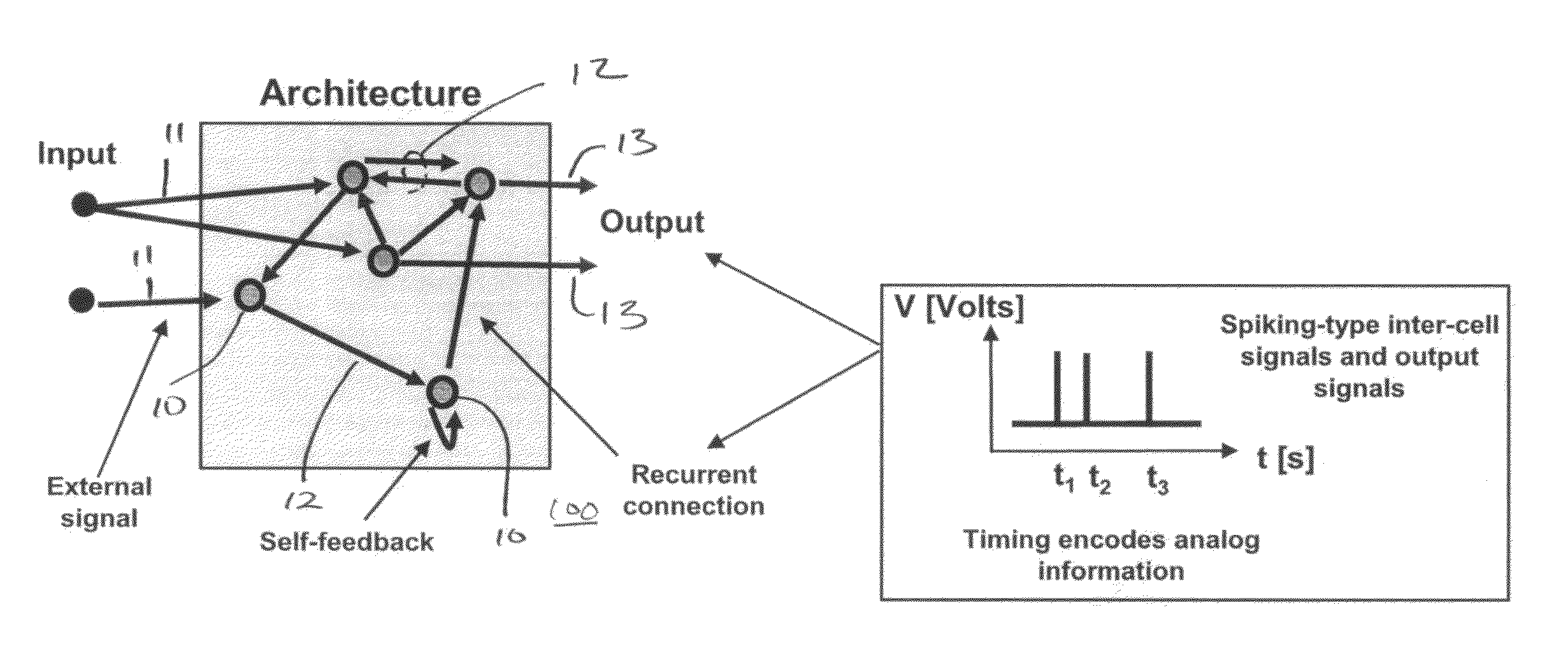Spike domain and pulse domain non-linear processors
a non-linear processor and pulse domain technology, applied in the field of signal processing in the onlinear network, can solve the problems of inability to compute, inability to achieve computation, and inability to accurately predict the dynamic range of analog components
- Summary
- Abstract
- Description
- Claims
- Application Information
AI Technical Summary
Problems solved by technology
Method used
Image
Examples
second embodiment
[0049]FIG. 2a is a diagram of the overall architecture of a type of neural computer. It is comprised of many cells 10 and can be said to comprise a recurrent network 100 of processing cells 10. Each cell 10 can receive external inputs. The external inputs 11 can be either analog or time encoded. As will be seen, time encoded inputs are preferred. Each cell 10 can also receive recurrent inputs from other cells 10 and from itself (self-feedback) via signal paths 12. All the inter-cell signals (on paths 12) and output signals (at outputs 13) are time encoded as spikes, in one embodiment, or as pulses, in a FIG. 2a depicts only five cells 10. However, it is to be understood that practical designs may typically include hundreds or thousands or even more cells 10. The number of cells 10 is a matter choice and their number as well as the number, pattern and signal weighting of the inter-cell signal paths 12 may well reflect the complexity of equations being solved by the network of FIG. 2...
first embodiment
[0052]FIGS. 3a-3c depict a cell 10. This embodiment is based on using spiking signals. A rather similar embodiment using pulse signals will be discussed briefly with respect to FIGS. 5a and 5b, which parrot FIGS. 3a-3c function-wise, but operate in the pulse domain rather then the spike domain.
[0053]As can be seen in FIG. 3a, each cell 10 is preferably composed of two front-end arrays of simple asynchronous 1-bit DACs (Digital to Analog Converters) 102 and 104. In many embodiments, these two arrays may well be thought of as a single array, since the 1-bit DACs in arrays 102, 104 are preferably identical to each other. The 1-bit DACs are depicted with gains g1, g2. . . , gn for array 104 and gf1, gf2, . . . , gfm for array 102. The subscripts n, m can logically be as large as the number of cells 10 in the neural network so that if the neural network has one hundred cells, then each cell 10 might have up to ninty-nine feedback inputs from other cells and perhaps self feedback also, br...
PUM
 Login to View More
Login to View More Abstract
Description
Claims
Application Information
 Login to View More
Login to View More - R&D
- Intellectual Property
- Life Sciences
- Materials
- Tech Scout
- Unparalleled Data Quality
- Higher Quality Content
- 60% Fewer Hallucinations
Browse by: Latest US Patents, China's latest patents, Technical Efficacy Thesaurus, Application Domain, Technology Topic, Popular Technical Reports.
© 2025 PatSnap. All rights reserved.Legal|Privacy policy|Modern Slavery Act Transparency Statement|Sitemap|About US| Contact US: help@patsnap.com



